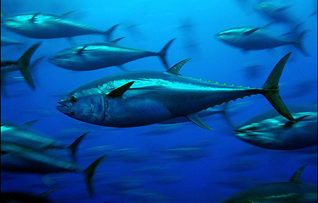 for “meiji-maguro” (young Pacific bluefin tuna) opened earlier than usual, with good catches in the East China Sea. The fish is normally caught in the Sea of Japan and the East China Sea to the east and south of Kyushu, respectively, from May to July, but good catches began to come in a few weeks early this year, starting in mid-April.
for “meiji-maguro” (young Pacific bluefin tuna) opened earlier than usual, with good catches in the East China Sea. The fish is normally caught in the Sea of Japan and the East China Sea to the east and south of Kyushu, respectively, from May to July, but good catches began to come in a few weeks early this year, starting in mid-April.As a result, the wholesale price at Tokyo’s Tsukiji Fish Market declined by half from the previous month, and average daily sales volumes in April were 30 times that of the same month last year, about 100 metric tons (MT) per day, according to the Nikkei Shimbun. Head-on gutted fish were JPY 500 (USD 4.92, EUR 3.53) per kg. As the price of fresh bonito tuna has been high in Japan this year, some supermarkets switched to offering young bluefin.
Meiji-maguro is defined as bluefin tuna under 3 years old and is more tender and lighter colored than the older fish. Harvest of the younger fish was expected to be curtailed under a cutback in the juvenile harvest agreed between Japan and the U.S. in September of last year and effective from February, but actually the quota reduction will have no effect.
The quota for juvenile bluefin tuna set by the Western and Central Pacific Fisheries Commission (WCPFC) allotted each fishing nation 15 percent less than its average catch from 2002 to 2004. For Japan, this would amount to 6,800 MT, but from 2010 to 2012, its actual catch has been less (averaging roughly 6,100 MT), so Japan could continue to catch the same actual amount as in recent years.
The United States had pushed for a 25 percent cut, but the WCPFC adopted Japan's proposal for a 15 percent reduction. A Japanese Fisheries Agency official conceded that future discussions will likely call for stricter regulations, but even a 25 percent reduction would be inadequate, according to a scientific study.
On 18 April the Pacific Bluefin Tuna Working Group of the International Scientific Committee (ISC) for Tuna and Tuna-like Species in the North Pacific Ocean released a report on Pacific bluefin tuna resources in the North Pacific that concluded the stock is overfished and there is a lack of breeding-age fish. Bluefin breed from age three, but too few reach that age due to overfishing.
The ISC is a scientific organization comprising Canada, China, Japan, Mexico, South Korea, Taiwan and the U.S. It assesses catch data to establish a scientific foundation for conservation efforts.
The data used in the study was from 1952 to 2012, as most nations adopted consistent catch reporting by 1952. Catches fluctuated widely over the period, peaking at 40,383 MT in 1956 and falling to a low of 8,653 MT in 1990. Juvenile tuna have always constituted the majority of the catch, recently accounting for approximately 70 percent. However, the catch of bluefin under age one increased significantly since the early 1990s as purse seines, which indiscriminately catch fish of all ages, became the dominant fishing method.
In the North Pacific Ocean, including Japanese waters, biomass of fish of a size capable of spawning totaled about 26,000 MT in 2012, down 40 percent from the historical average of 43,000 MT since 1952.
The report projects the results of various possible recovery plans, and finds that only by halving catches of fish under age three in the West Central Pacific Ocean from the 2002-2004 average, and also halving the total harvest in the Eastern North Pacific from 5,500 MT to 2750 MT, can Pacific bluefin tuna recover to their historical average level of recruitment within 10 years.
The report also projects that a continuation of the 15 percent reduction in juvenile harvest adopted by the WCPFC, and the Inter-American Tropical Tuna Commission’s recommendation of a commercial catch limit of 5000 MT (with an additional 500 MT quota for any country with a catch history), would not prevent the spawning stock biomass from marking a new low.
Limitations on catch method are not specifically proposed, but hook-and-line fishermen in Japan have pointed the finger at purse seiners for the declining stock.
While fish farming may appear as an alternative to wild, most bluefin aquaculture pens are stocked with wild-caught juveniles. Closed-cycle breeding, developed in Japan, is not yet economically competitive outside of a government-subsidized university research environment and still makes up a small percentage of production.





